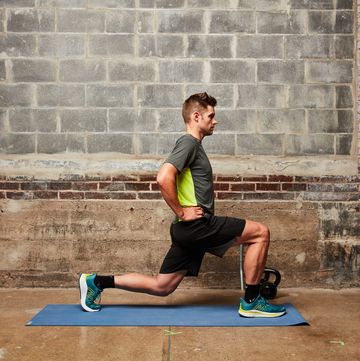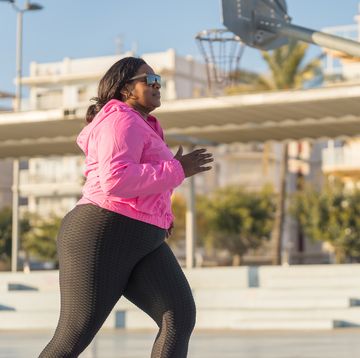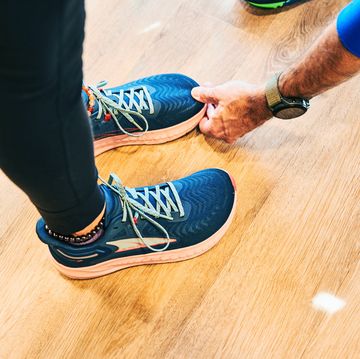Whether you got inspired to start running after watching a road race or received some encouragement from a friend or a doctor, figuring out where to begin can feel overwhelming. But the steps to creating a consistent run routine are simple, especially when you have these beginner-friendly tips and training plans designed to help you ease into the sport.
Follow this easy guide on how to start running today, complete with strategies and programs that set you up for success.
1. Just Get Out There
As a beginner, you can spend all week/month/year thinking about how to run and browsing the web for tips and plans, or you can just get out there regularly. “The biggest thing when you first start out is establishing the habit—getting used to being on your feet,” says Matthew Meyer, certified run coach and trainer based in Boulder, Colorado.
Forget about hitting a certain pace (turn that watch around!), ditch the idea of reaching a certain distance, and instead, just set a time goal. Meyer says a good beginner running target is to get outside or on a treadmill for 20 minutes, three days a week. Eventually, aim to build up to four days, and then you can bump 20 minutes to 25 and so on.
2. Embrace the Run-Walk Method
It’s here, in the beginning, when many new runners stumble. You think, “Today, I’m going to start running!” and out the door you go with the best of intentions—but maybe not the best preparation. Four minutes later, everything hurts, and you feel like you are dying. Don’t despair. Whether you’re fresh off the couch or coming from another sport, running takes time to break into.
“Every able-bodied person can be a runner,” says Gordon Bakoulis, a RRCA-certified run coach with New York Road Runners. “Just start slowly and build up gradually.” Most coaches agree that the best way to become a runner is with a run-walk program.
With a time goal in mind, focus on a few minutes of running, followed by a period of walking. Meyer suggests aiming to run for three minutes and walking for one minute—continue to alternate until you reach the time goal, always ending with a walking segment to cool down. But you can always play around with different run-walk intervals to find what works best for you.
If you’re not comfortable with just a one-minute walk between rounds, Christine Hinton, a RRCA-certified coach in Annapolis, Maryland, says it’s okay to start with four minutes of walking and just two minutes of running as an alternative.
For a more structured program, check out our start running training plans:
Run 1 Mile
Never ran a mile nonstop? This plan is for you. You’ll start with just 10 to 15 minutes of walking four days a week and add in more time and intensity from there—until you hit one full mile at the end of eight weeks.
Beginner Running Plan
This 12-step program begins with just 30 minutes of nonstop walking. You’ll then gradually add in run intervals, starting with one minute. You can do these run-walk workouts as many days of the week as you can.
Run for Weight Loss
If losing weight is your main goal, this plan can get you there. It’s might also bring on some added benefits, like boosted mood and better health. You’ll start with 30-minute walks and slowly add in run intervals.
Run Non-Stop
This seven-week plan includes run-walk intervals, which begin at 25 minutes. You’ll work out five days a week, with two rest days.
No matter how long you’re going for, think about reaching a 6 to 7 out of 10 in terms of your exertion level during those run periods, then dial it down to 2 or 3 during the walk. That means you should still be able to have a conversation during those run periods, Meyer says.
3. Consider Proper Technique
A warmup and cooldown will help you ease in and out of a run. Start with a few reverse lunges on each leg, followed by squats, side lunges, butt kicks, and high knees before your run. After, take a few minutes to walk slowly, then foam roll your legs (the quads, hamstrings, and calves are good places to work on) or stretch.
“A good warmup makes it much easier to get going and keep going,” says Andrew Kastor, head coach of Mammoth Track Club. “It’s much more than just boosting blood flow to your muscles.” Your neuromuscular system, which involves your brain telling your muscles how to contract, gets up to speed. Your body starts churning out fat-burning enzymes, which help your aerobic system work more efficiently. Synovial fluid warms up, which helps lubricate your joints. “Too many beginners skip this step without realizing how much easier it makes the whole workout feel,” Kastor says.
Cooling down, while less critical, allows your body to gradually adjust from running back to a resting state. “Just a few minutes of walking is all you need to let your heart rate return to normal and for your body to clear out any metabolic waste you created during your efforts,” Kastor adds.
Even (and especially) in the early stages of running, you also want to think about form. Meyer has a few simple questions he tells his clients to ask themselves on the road: Am I leaning forward through the chest? Are my arms swinging? Is my core engaged? Are my knees driving? Are my heels nice and high? “Really focus on picking up your heels behind you, especially if you’re feeling tired and your legs are feeling heavy to take your mind off the run for a little,” he says.
4. Explore New Places
An easy way to keep your motivation up on the run? Finding a new area to discover, Meyer says. “I remember when I first started running, I would seek out interesting parks or places I hadn’t been before,” he says. “You want to get moving, but you also want to be in a beautiful place to get to know and spend time exploring.”
It even helps to explore different running surfaces. Runners often have strong opinions about where to run, but the best solution for you as a new runner may be to simply mix it up, says Shelly Florence-Glover, exercise physiologist and co-author of The Competitive Runner’s Handbook. The options include: new roads, park paths, urban greenways, dirt trails, your local track, that huge neighborhood hill, the gym treadmill, and more.
“Soft is not necessarily better,” she says. “Both treadmills and dirt may seem ‘softer’ and therefore safer, but they have their issues. A treadmill belt has a slight shimmy when the belt impacts the bed that can contribute to shin issues. Dirt and trails can be uneven and have holes and ruts. Keep it varied—maybe sidewalk one day, paved road the next, and a trail on the weekends.”
5. Progress Slowly
When you feel comfortable running 20 to 30 minutes at an easy pace (when your exertion level drops below 6, and you feel confident in taking it up a notch), then it’s time to increase the challenge. Your next step is to either extend your total workout time or the number of runs each week. But choose just one option at a time, Meyer says.
For example, you could aim to go for 30 minutes instead of 20. Or run four times a week instead of three. A very important rule of thumb: Increase your total weekly time or distance by no more than 10 percent from week to week. For example: If this week you ran 90 minutes total, you’ll run 99 next week. Or if you ran 10 miles total this week, you’ll run 11 total next week.
It’s easy to overdo it on the days you feel good, or when you’re running with a faster friend. But doing too much too soon is a classic rookie mistake that can lead to injury and burnout. “When you’re first starting out, your goal should just be to have fun,” says Glover. Once you’re running consistently, you can add days until you’re running five days a week or more.
6. Don’t Get Discouraged
A few things to think about when you start to feel like you just want to stop: For starters, really focus on why you decided to start running. “Whenever I’m in the middle of a really hard workout, I remember, ‘You chose this, and you really love this,’” says Meyer. “Even when it gets hard, there’s a reason you got out in the first place.”
Before you start your next run, Meyer recommends deciding what you want to get out of it to keep your focus. Do you want to get outside and enjoy it? Do you want to end smiling and feeling good? Do you want to get mentally or physically stronger? Do you just want to sweat a little? Whatever it is, point it out and use it as your motivation to just keep going.
Also, don’t dwell on one bad run, because everyone has them. Yes, even the pros. “Running is more of a collection of work—day by day, you work for it—and it’s at the end that you see everything. So just focus on showing up a little bit every day. Some days you’ll feel amazing; some days you’ll feel terrible,” Meyer says. “Success is not determined by one day, but by all of them put together.”
In the end, running should be fun; and even veteran runners use outside assistance to keep the enjoyment factor high.
Tools To Help You Stay Inspired
A Training Log
A simple journal offers insight into how far you’ve come, what’s working, what’s not, and keeps you on track to meet your goals. Some items to consider recording: type of run (duration/miles/special workout); effort level; food and drink consumed before, during, and after; weather; and how you felt.
Running Partners
The American College of Sports Medicine recommends having an exercise partner because it improves the odds that you’ll stick with working out. Here’s why: Your run flies by when you’re talking with a friend, and knowing a partner is waiting for you is great motivation to leave the comfort of your chair.
Music
If you’ve ever taken a studio fitness class, then you know the powerful effect music can have on performance. “Certain types of music can help lower the perception of fatigue and enhance feelings of vigor and excitement,” says sports and exercise psychologist Costas Karageorghis, Ph.D., psychologist at West London’s Brunel University. Just be sure to keep the volume low or opt for open-air earphones so you’re aware of your surroundings.
Gear
Go to a specialty running store where trained professionals will evaluate your feet, watch you run, recommend the right shoes, and then let you go out for a test drive. You’ll leave with a comfortable pair of shoes that will have you running pain- and injury-free.
Finally, always remember that you’re a runner, no matter how much time you put in and whether you walk or not. “All you have to do is show up, put one foot in front of the other, and you’re a runner,” Meyer says. Don’t forget it!

Mallory Creveling, an ACE-certified personal trainer and RRCA-certified run coach, joined the Runner's World and Bicycling team in August 2021. She has more than a decade of experience covering fitness, health, and nutrition. As a freelance writer, her work appeared in Women's Health, Self, Men's Journal, Reader's Digest, and more. She has also held staff editorial positions at Family Circle and Shape magazines, as well as DailyBurn.com. A former New Yorker/Brooklynite, she's now based in Easton, PA.













